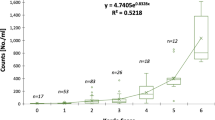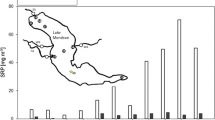Abstract
Phytoplankton samples from 7 different lakes were processed in 2 intercalibration series using Utermöhl's sedimentation method. Total biomass volumes obtained by most of the investigators give reliable results in respect to the mean. Numbers of individuals and mean volumes of selected species obtained by the different participants were compared and show larger variations than the overall results. Therefore a certain delimitation of particular sources of errors was tried in the 2nd intercalibration series by giving recommendations for the different steps of the whole procedure.
Similar content being viewed by others
References
Bailey-Watts, A.E.: A nine-year study of the phytoplankton of the eutrophic and non-stratifying Loch Leven (Kinross, Scotland). J. Ecol.66, 741–771 (1978).
Bailey-Watts, A. E., and Karika, A.: The assessment of size variation in Loch Leven phytoplanton: methodology and some of its uses in the study of factors influencing size. J. Plankt Res., in press (1981).
Bürgi, H.R.: 2. Internationaler Workshop aktiver Phytoplanktologen. 21. bis 27. August 1978 in Kastanienbaum. Verhandlungsbericht. Schweiz. Z. Hydrol.40/2, 306–309 (1978).
Burnham, J.C., Stetak, T.H., and Boulger, J.: An improved method of cell enumeration for filamentous algae and bacteria. J. Phycol.9, 346–349 (1973).
Cronberg, G.: Phytoplankton changes in lake Trummen induced by restoration. Thesis, Univ. Lund, 117 p. (1980).
Edler, L. (ed.): Recommendations for marine biological studies in the Baltic sea, phytoplankton and chlorophyll. Baltic Mar. Biolog.5, 38 p. (1979).
Elliott, J.M.: Some methods for the statistical analysis of samples of benthic invertebrates. Freshwat. Biol. Ass.25, 2nd ed., 2nd impr., 156 p. (1979).
Eloranta, P.: Effects of size of sample counted in phytoplankton analyses. Ann. Bot. Fenn.,15, 169–176 (1978).
Fricker, H.J.: OECD Eutrophication Programme, Regional Report Alpine Lakes; Swiss Federal Board for Environmental Protection, Switzerland (1980).
Hasle, G.R.: ‘The inverted microscope method’ and ‘Identification problems. General recommendations’. In: Sournia, A. (ed.): Phytoplankton manual. UNESCO Monogr. Oceanogr. Method., Paris6, 88–97 (1978).
Hobro, R., and Willén, E.: Phytoplankton counting and volume calculations from the Baltic—a method comparison. Vatten4, 317–325 (1975).
Hobro, R., and Willén, E.: Phytoplankton countings. Intercalibration results and recommendations for routine work. Int. Revue ges. Hydrobiol.62, 805–811 (1977).
Humphries, S.E., and Widjaja, F.: A simple method for separating cells ofMicrocystis aeruginosa for counting. Br. phycol. J.14 313–316 (1979).
Javornicky, P.: Die Revision einiger Methoden zum Feststellen der Quantität des Phytoplanktons (Revise nekterych method pro zjistovani kvantity fytoplanktonu). Sb. vys. Sk. chem.-technol. Praze, Oddil fakulty technologie paliv a vody, Prague2, 283–367 (1958).
Larsson, K., Weibull C., and Cronberg, G.: Comparison of light and electron microscopic determinations of the number of bacteria and algae in lake waters. Appl. Environ. Microbiol.35, 397–404 (1978).
Lorenzen, C.J.: Determination of chlorophyll and phaeopigments: spectrophotometric equations. Limnol. Oceanogr.12, 343–346 (1967).
Lund, J.W.G., Kipling, C. and Le Cren, E.D.: The inverted microscope method of estimating algal numbers and the statistical basis of estimation by counting. Hydrobiologia11, 143–170 (1958).
Nauwerck, A.: Die Beziehungen zwischen Zooplankton und Phytoplankton im See Erken. Symbol. Bot. Upsal.17, 163 p. (1963).
Olson, F.C.W.: Quantitative estimates of filamentous algae. Trans. Am. Microsc. Soc.69, 272–279 (1950).
Reynolds, C.S., and Jaworski, G.H.M.: Enumeration of naturalMicrocystis populations. Br. phycol. J.13, 269–277 (1978).
Rott, E.: Chlorophyll-a-Konzentration und Zellvolumen als Parameter der Phytoplanktonbiomasse. Ber. nat.-med. Ver. Innsbruck65, 11–21 (1978).
Throndson, J.: Preservation and storage. In: Sournia, A. (ed.): Phytoplankton manual. UNESCO Monogr. Oceanogr. Method., Paris6, 69–75 (1978).
Uehlinger, V.: Etude statistique des méthodes de dénobrement planctonique. Thesis, Univ. Geneva, 223 p. (1974).
UNESCO: A review of methods used for quantitative phytoplankton studies: UNESCO techn. Pap. marine Sci.18, 27 p. (1974).
Utermöhl, H.: Neue Wege in der quantitativen Erfassung des Planktons. Verh. int. Verein. Limnol.5, 567–596 (1931).
Utermöhl, H.: Zur Vervollkommung der quantitativen Phytoplankton-Methodik. Mitt. int. Verein. theor. angew. Limnol.9, 38 p. (1958).
Venrick, E.L.: ‘The implications of subsampling’ and ‘How many cells to count?’ In: Sournia, A, (ed.), Phytoplankton manual, UNESCO Monogr. Oceanogr. Method., Paris6, 75–88, 167–181 (1978).
Willén, E.: A simplified method of phytoplankton counting. Br. phycol. J.11, 265–278 (1976).
Author information
Authors and Affiliations
Rights and permissions
About this article
Cite this article
Rott, E. Some results from phytoplankton counting intercalibrations. Schweiz. Z. Hydrologie 43, 34–62 (1981). https://doi.org/10.1007/BF02502471
Received:
Issue Date:
DOI: https://doi.org/10.1007/BF02502471




